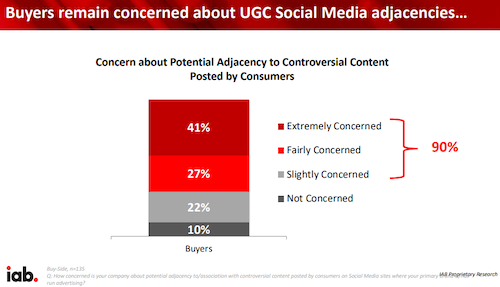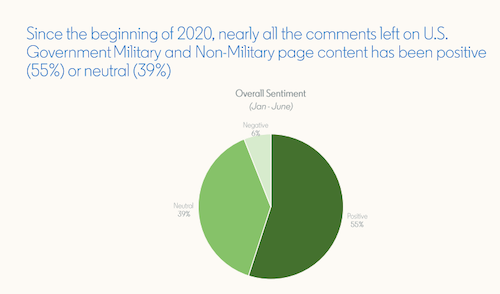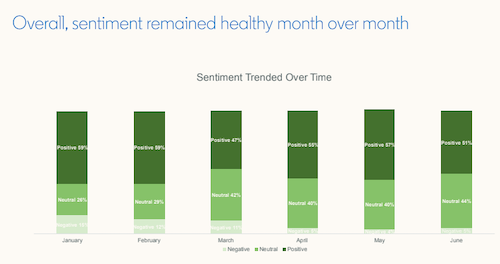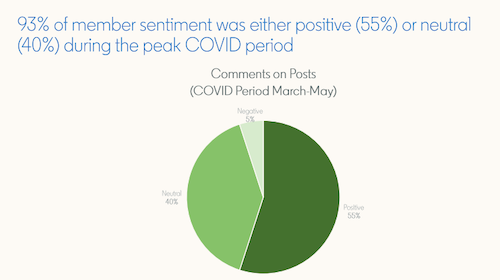What We Learned from a Government Sentiment Analysis on LinkedIn
Editor's Note: This blog post was co-written by Matt Ross, Client Partner, LinkedIn Marketing Solutions.
If there’s been a more challenging time to be in advertising and marketing, I can’t recall it.
As ever, we all have our own business goals, strategies, and campaigns to focus on. But with so much happening around us in the world, we need to avoid getting trapped by tunnel vision. Brand safety weighs more heavily than ever, making it essential to be thoughtful regarding what we’re talking about, where we’re showing up, and what’s being seen alongside our messages.
This can be a particularly delicate line to walk on social media, where user-generated content takes center stage and drives the conversations. A recent survey by IAB looking at COVID Ad Spend Impact in 2020/21 confirms: 90% of buy-side advertisers in the survey said they are at least slightly concerned about their ads being potentially adjacent to controversial content on social media.

At LinkedIn, we recently conducted a Sentiment Analysis of U.S. Government Company Page Content to understand how audiences are responding to communications and content from government entities on our platform in the current environment. Because these orgs are inherently motivated to be cautious about maintaining an air of credibility, accuracy, and safety with their public-facing content, we felt they might offer cues and guidance for all businesses navigating the uncertainty.
Sentiment Analysis of Government Company Page Content on LinkedIn: Key Takeaways
Our analysis covered the time period from January through June of 2020, and looked at more than 30 federal government LinkedIn Pages, both military and non-military. We examined both organic updates and Sponsored Content shared by these organizations, and analyzed the sentiment of comments in response using a combination of Python processing and manual validation.
Some of our findings:
Comment backlash hasn’t been an issue on LinkedIn
When you click “publish” as an advertiser or content creator, you never know what kind of feedback and comments might surface beneath it, which can be a source of stress — especially at a time of so much controversy and consternation in the country. On LinkedIn, government Pages are largely steering clear of negative backlash.
Our study found that over the first half of 2020, nearly all the comments left on U.S. government military or non-military LinkedIn Page content have been positive (55%) or neutral (39%).
Positive sentiment has been steady over time
It may seem counterintuitive, because the state of the world certainly hasn’t stayed the same, but sentiment did not take a sharp turn toward negativity on these LinkedIn Pages even as the pandemic’s impact grew and other societal issues rose to the forefront. To the contrary: discussions have remained relatively upbeat. There wasn’t a single month in our study where positive sentiment did not outweigh neutral sentiment, and in fact negative sentiment has declined over time.
Commenters didn’t go negative in the face of COVID
One might suspect a sharp turn toward negativity at the height of COVID’s outbreak, but we found that during the peak pandemic period (March through May), 95% of comments on government content carried sentiment that was either positive (55%) or neutral (40%).
What to Make of These Insights?
Needless to say, the enduring level of positive sentiment seen here is not universally found across the social media landscape during turbulent times. Why are government organizations seeing it on LinkedIn?
It really comes down to the nature of LinkedIn members, and their intent when they come to the platform. Because we host a community of individuals who are representing their professional identities, and openly sharing rich profile information, they tend to be more careful about what they say, and more likely to censor inflammatory comments.
Put another way: you’re less apt to encounter divisive arguments and political memes on LinkedIn. As this sentiment survey illustrates, the platform tends to provide a safer and more inviting environment than some others for government organizations to share serious information and engage in real conversations with their audiences.
This is important to keep in mind as you chart your strategic roadmap for the rest of 2020 and into 2021. Because even amid widespread disruption, the show must go on: Despite the reservations expressed about adjacency to controversial content on social media in the IAB survey, buy-side respondents still indicated that they expected to increase spend on social media by 25% year-over-year from 2019.
Stand by your message and broadcast it proudly. Just make sure you’re doing it in a setting where your brand, and its customers, can feel trusting and comfortable.
For more guidance on keeping your marketing engine running effectively through changing circumstances, subscribe to the LinkedIn Marketing Blog.







